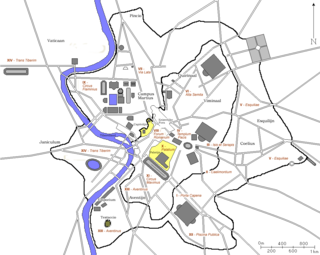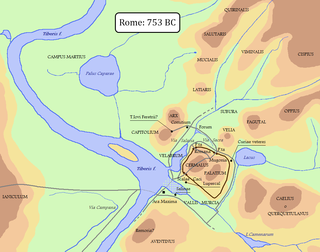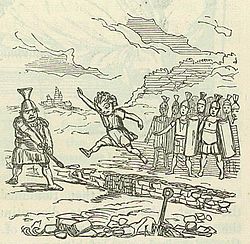
The founding of Rome was a prehistoric event or process later greatly embellished by Roman historians and poets. Archaeological evidence indicates that Rome developed from the gradual union of several hilltop villages during the Final Bronze Age or early Iron Age. Prehistoric habitation of the Italian Peninsula occurred by 48,000 years ago, with the area of Rome being settled by around 1600 BC. Some evidence on the Capitoline Hill possibly dates as early as c. 1700 BC and the nearby valley that later housed the Roman Forum had a developed necropolis by at least 1000 BC. The combination of the hilltop settlements into a single polity by the later 8th century BC was probably influenced by the trend for city-state formation emerging from ancient Greece.

In Roman mythology, Romulus and Remus are twin brothers whose story tells of the events that led to the founding of the city of Rome and the Roman Kingdom by Romulus, following his fratricide of Remus. The image of a she-wolf suckling the twins in their infancy has been a symbol of the city of Rome and the ancient Romans since at least the 3rd century BC. Although the tale takes place before the founding of Rome around 750 BC, the earliest known written account of the myth is from the late 3rd century BC. Possible historical bases for the story, and interpretations of its local variants, are subjects of ongoing debate.

The Roman Forum, also known by its Latin name Forum Romanum, is a rectangular forum (plaza) surrounded by the ruins of several important ancient government buildings at the centre of the city of Rome. Citizens of the ancient city referred to this space, originally a marketplace, as the Forum Magnum, or simply the Forum.

The Aventine Hill is one of the Seven Hills on which ancient Rome was built. It belongs to Ripa, the modern twelfth rione, or ward, of Rome.

The Palatine Hill, which relative to the seven hills of Rome is the centremost, is one of the most ancient parts of the city; it has been called "the first nucleus of the Roman Empire". The site is now mainly a large open-air museum whilst the Palatine Museum houses many finds from the excavations here and from other ancient Italian sites.
Curia in ancient Rome referred to one of the original groupings of the citizenry, eventually numbering 30, and later every Roman citizen was presumed to belong to one. While they originally probably had wider powers, they came to meet for only a few purposes by the end of the Republic: to confirm the election of magistrates with imperium, to witness the installation of priests, the making of wills, and to carry out certain adoptions.

The Domus Aurea was a vast landscaped complex built by the Emperor Nero largely on the Oppian Hill in the heart of ancient Rome after the great fire in 64 AD had destroyed a large part of the city.

The pomerium or pomoerium was a religious boundary around the city of Rome and cities controlled by Rome. In legal terms, Rome existed only within its pomerium; everything beyond it was simply territory (ager) belonging to Rome.

The Suburra, or Subura was a vast and populous neighborhood of Ancient Rome, located below the Murus Terreus on the Carinae and stretching on the slopes of the Quirinal and Viminal hills up to the offshoots of the Esquiline.

Trajan's Forum was the last of the Imperial fora to be constructed in ancient Rome. The architect Apollodorus of Damascus oversaw its construction.

In 7 BC, Augustus divided the city of Rome into 14 administrative regions. These replaced the four regiones—or "quarters"—traditionally attributed to Servius Tullius, sixth king of Rome. They were further divided into official neighborhoods.

Andrea Carandini is an Italian professor of archaeology specialising in ancient Rome. Among his many excavations is the villa of Settefinestre.
Clementina Panella is an Italian archaeologist, a professor at the University of Rome La Sapienza, where she teaches Methodology of Archaeology. She has guided and co-written a number of articles on the commercial pottery of ancient Italy.

Romulus was the legendary founder and first king of Rome. Various traditions attribute the establishment of many of Rome's oldest legal, political, religious, and social institutions to Romulus and his contemporaries. Although many of these traditions incorporate elements of folklore, and it is not clear to what extent a historical figure underlies the mythical Romulus, the events and institutions ascribed to him were central to the myths surrounding Rome's origins and cultural traditions.

Roma quadrata was an area or structure within the original pomerium of the ancient city of Rome, probably the Palatine Hill with both its Palatium and Cermalus peaks and their slopes. It apparently dated to the earliest stage of the city's formation. The original meaning had already become obscure to both Latin and Greek historians by the late Roman Republic.
In ancient Roman funerals, an ustrinum was the site of a cremation funeral pyre whose ashes were removed for interment elsewhere. The ancient Greek equivalent was a καύστρα. Ustrina could be used many times. A single-use cremation site that also functioned as a tomb was a bustum.

The Casa Romuli, also known as the tugurium Romuli, was the reputed dwelling place of the legendary founder and first king of Rome, Romulus. It was situated on the south-western corner of the Palatine hill, where it slopes down towards the Circus Maximus, near the so-called "Steps of Cacus". It was a traditional single-roomed peasants' hut of the Latins, with straw roof and wattle-and-daub walls, such as are reproduced in miniature in the distinctive funerary urns of the so-called Latial culture.

The following outline is provided as an overview of and topical guide to Rome:

The Regio X Palatium is the tenth regio of imperial Rome, under Augustus's administrative reform. Regio X took its name from the Palatine Hill and the imperial palaces located on it.

The sulcus primigenius was the ancient Roman ritual of plowing the boundary of a new city—particularly formal colonies—prior to distributing its lots or erecting its walls. The Romans considered the ritual extremely ancient, believing their own founder Romulus had introduced it from the Etruscans, who had also fortified most of their cities. The ritual had the function of rendering the course of the city wall sacrosanct but, owing to the necessity of some profane traffic such as the removal of corpses to graveyards, the city gates were left exempted from the ritual.



















